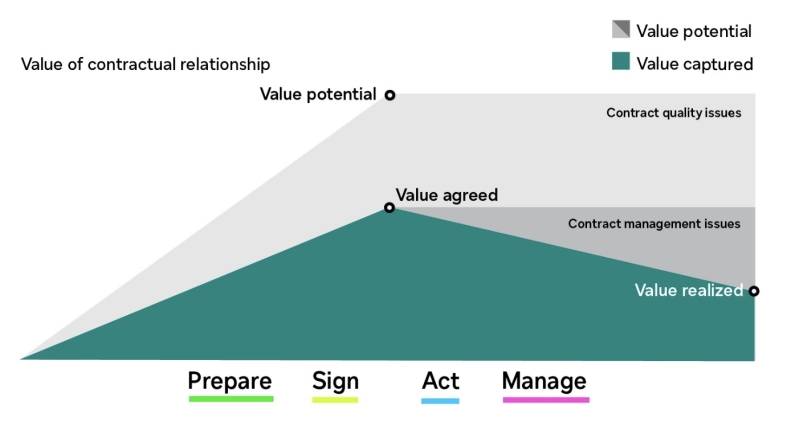Understanding and Reducing Contract Value Leakage
Over the lifespan of a business agreement, contracts often fail to deliver their full potential and might even lose value. There’s a term for the difference between the potential value of an agreement and value that is actually realized—contract value leakage.
As modern systems of agreement become more complex and evolve to include a broader range of end-to-end capabilities, it’s important for organizations to take a look at their contract workflows and recalculate the dollars-and-cents impact of those tools. In DocuSign’s Recalculating the Value of a Modern System of Agreement ebook, we’ve identified six key ways that better agreements can translate to better revenue.
Contract value leakage is the single biggest opportunity for modern organizations to turn agreement practices into dollars and cents. Leakage can happen both before signature (signing suboptimal contracts) and in execution (poor understanding of agreement contents and inability to execute the terms).

To examine value leakage further, it helps to explore tactical examples of modern problems that contribute to leakage. Consider the example of a company that sells online services. For each sale, the company creates a contract, negotiates terms with potential customers, executes the terms and attempts to renew with the customer at the expiration of the contract. Below are the opportunities for value leakage in that process. To add clarity, these problems will be discussed in two broader categories: contract quality issues and contract management issues.
Contract quality
Value leakage that occurs before the point of signature is the result of poor contract quality. These issues generally account for around two-thirds of all leakage. Value leakage from contract quality occurs when parties sign agreements that haven’t been optimized in the preparation and negotiation stages, so they contain suboptimal language for the parties. Here are some common contract quality errors that our example online services company could make:
- Value left on the table: Over the course of a negotiation, the company agrees to sell its service to a customer at a price point that is lower than what other customers have agreed is the accepted price.
- Unfavorable commitments: The company accepts terms inserted in an agreement by a customer and unknowingly agrees to severe penalties for service failures and liability overcommitments.
- Vague performance metrics: The company agrees to a vendor contract without clear specifications about the performance of a product. When a defective product is delivered, the company must invest time and resources to correct the problem, increasing total cost of ownership. Alternatively, the company could take legal action, which would also increase cost.
Contract management
Value leakage that occurs after the point of signature is the result of poor contract management. The biggest problem at this stage is that companies have poor visibility into the content of their agreements and fail to act on terms that they have agreed to. Because of these deficiencies, companies miss opportunities to renew contracts accurately and favorably. The following are contract management mistakes that our sample company could make:
- Delivery/compensation errors: Without the proper visibility into the contract obligations, the company completes a sale but fails to provide the service to the customer in a timely manner. Similar errors could be made regarding the quality or completeness of the service. Along the same lines, the company may also activate the service but fail to collect payment correctly.
- Unenforced obligations: Depending on activity that happens after activation, customers may owe the company penalties or fees for additional services, exceeded thresholds or missed obligations. If the company doesn’t have a firm grasp of the contents of its agreements, it will miss these opportunities for additional revenue.
- Change management failures: As the company and the business landscape evolve over the course of an agreement’s lifecycle, changes may need to be made. Regulatory changes or other events may require new action to be taken to uphold responsibilities or stay in compliance. This is especially relevant when the company negotiates renewal contracts.
There are several negative consequences of contract value leakage, but the primary impacts are foregone financial benefits, ongoing costs (both direct and indirect), avoidable penalties and lost opportunities for renewal, cross-sell or upsell.
One way to reduce contract value leakage is to utilize a modern system of agreement that will standardize agreement generation, analyze existing (or new) agreements quickly and connect critical business tools to take action on contract terms. With uniform agreements that are generated from a library of preapproved templates and clauses, contract quality will improve significantly. Once the agreement is signed by all parties, that system can further minimize leakage by analyzing contracts to respond to events and automate any necessary actions.
Another feature of cutting-edge systems of agreement is the ability to ingest any number of existing agreements, in almost any format and from almost any location. These files can be uploaded and transformed into a searchable document in the system of record.
Download the Recalculating the Value of a Modern System of Agreement ebook to learn more about contract value leakage and other ways that digital agreement tools can turn into value for your organization.